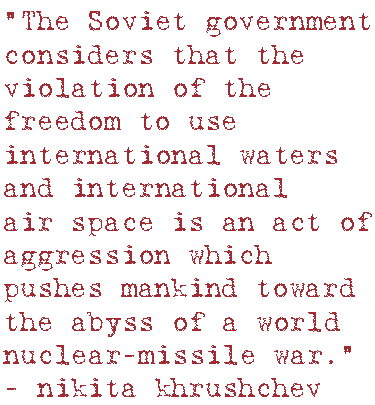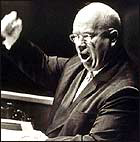Wednesday, 24 October 1962
On the 23rd, at 7:06 p.m. in Washington, Kennedy signed the quarantine proclamation. It was transmitted and delivered to the Soviets at 6:00 a.m. Moscow Time (11:00 p.m. 23 October, Washington time).66
The following day, 24 October 1962, a response from Khrushchev came to Kennedy via a Telegrafnoe Agentstvo Sovetskogo Soyuza (TASS – the Soviet news agency) broadcast declaring that “The Soviet government will not take any actions which would be reckless… We shall do everything in our power to prevent war from breaking out.” The broadcast agreed that a “top-level meeting” would be useful but that the US should avoid “piratical threats” and that the Soviet government “cannot accept them in any form.” Khrushchev repositioned responsibility for catastrophe back on the Americans by stating, “if the American government carries out the program of pirate action it planned then of course we shall have to make use of the means of defense against the aggressor. We have no other way out.”67 The Chairman’s creative and unprecedented use of TASS to broadcast his message to Kennedy displayed his determination to ensure Kennedy knew the Soviets would do everything in their power to prevent war.
“The Soviet government will not take any actions which would be reckless… We shall do everything in our power to prevent war from breaking out.” The broadcast agreed that a “top-level meeting” would be useful but that the US should avoid “piratical threats” and that the Soviet government “cannot accept them in any form.” Khrushchev repositioned responsibility for catastrophe back on the Americans by stating, “if the American government carries out the program of pirate action it planned then of course we shall have to make use of the means of defense against the aggressor. We have no other way out.”67 The Chairman’s creative and unprecedented use of TASS to broadcast his message to Kennedy displayed his determination to ensure Kennedy knew the Soviets would do everything in their power to prevent war.
Khrushchev’s letter of 24 October refused Kennedy’s demands and refused to recognize the authority of the OAS to decree such quarantine. Khrushchev further advised Kennedy, “The Soviet government considers that the violation of the freedom to use international waters and international air space is an act of aggression which pushes mankind toward the abyss of a world nuclear-missile war.”68 This effort attempted to reverse the blame for the conflict and at the same time gain absolution for results should Soviet ships defend themselves.
decree such quarantine. Khrushchev further advised Kennedy, “The Soviet government considers that the violation of the freedom to use international waters and international air space is an act of aggression which pushes mankind toward the abyss of a world nuclear-missile war.”68 This effort attempted to reverse the blame for the conflict and at the same time gain absolution for results should Soviet ships defend themselves.
The rapid Soviet response clearly expressed their desire not to start a war. The words, however, illustrated that the Soviets were stalling for more time by threatening nuclear war. They did this to further develop the situation to enable conditions more favorable to their negotiations and shore up their diplomatic arguments against the quarantine proclamation.
Also on the 24th, acting Secretary General U Thant appealed to both Kennedy and Khrushchev to participate in a “voluntary suspension for a period of two to three weeks [to] greatly ease the situation and give some time to the parties to meet and discuss with [them] a view to finding a peaceful solution to the problem.”69 U Thant further asked President Kennedy not to confront Soviet vessels.70
U Thant sought more time to stabilize the situation to allow the aggrieved parties to come to the negotiating table. A pause, however, helped Khrushchev by allowing the completion of the missiles with equipment already in Cuba and hurt Kennedy for the same reason.
The idea of negotiating the missiles out of Turkey and Italy gained momentum with the Executive Committee. Near midday, George Ball contacted the United States Ambassador to Turkey Thomas Finletter instructing him to begin investigating that option.71
Within the Department of Defense, at 10:00 p.m. SAC announced a full nuclear alert – DEFCON 2.72 The Department also informed the Soviet government of the procedures the Navy would use to signal a submarine with instructions to surface and identify itself.73 Further, in a belated effort to aid communication, the Navy moved thirteen available Russian-speaking sailors to the task force while maintaining six in reserve.74
The almost reckless approach to signaling the Soviet submarines and the lack of ready and available Soviet language experts demonstrated that the United States military was ill-prepared to confront the Soviets in any manner that would not lead to war.

